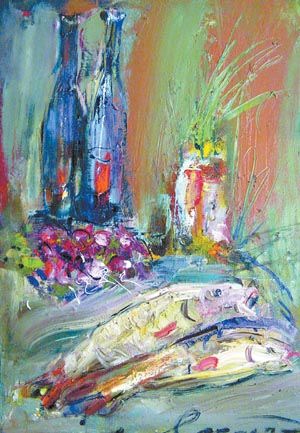“To the country” (An exhibit with many interpretations)
Artist Serhii YAROTSKY: Isms persecute artists more persistently than other people
Last week the Lviv Palace of Arts launched the exhibit “U krai” (“To the country”), with canvases by four Ukrainian modern artists. They differ in terms of age, painting style, and artistic methods, yet they are united by a deeper principle. Below The Day discusses this principle with Serhii YAROTSKY, an artist and the exhibit’s curator.
Mr. Yarotsky, the title “U krai” offers many interpretations.
“I would like people to seek as many interpretations as possible. There are never too many meanings. This title can be interpreted like ‘edge,’ ‘limit,’ ‘land,’ ‘country,’ ‘extremely,’ ‘quite.’ You can read this title in a variety of ways, and every interpretation will be correct.”
Who are the four artists taking part in the exhibit? What principle has united you?
“Those are Viktoria Kovalchuk (Lviv), Roman Hurhula (Halych), Bohdan Brynsky (Ivano-Frankivsk) and myself. The union appeared in a most natural way. As for the principle… Frequently we feel as if we were between a pulsing living thing and an unfeeling dead one. At the same time the sphere of ideal things never leaves us, we live and seek to attain these ideals. Yet ideals fade away. You know, everything has limits, and there is nothing more ambiguous than this notion. ‘U krai’ is on the verge of the ideal and the absence of it. ‘U krai’ is on the verge of poetry and philosophy. ‘U krai’ is on the verge of historical and supra-historical things.
“I want to bring to the people my vision of the apophaticism of the surrounding world. As is known, Christianity has a long tradition of apophaticism, i.e., description of God as Absolute via consistent denial of all the definitions that are ascribed to Him, which are not comparable to His nature. The bright representatives of apophatic theology in Christianity are Dionysius Areopagitus and Gregorius Nyssenus. Why apophaticism? I think that a correct understanding of this phenomenon could help us live today. A real apophaticism against apophaticism. You know, Lina Kostenko once said: When will we learn to speak with the word ‘not’?”
You’re an artist and a curator at the same time. Isn’t it difficult to combine these activities?
“I have never imagined that I would become a curator. However, I thought about this possibility for quite a long time. When I started to paint a church, I thought that I needed assistance. The process of painting Sts. Peter and Paul’s Church, located in the village Davydiv near Lviv has lasted for over four years, and it has not been completed yet. The same goes for exhibits. Today it is more interesting, and simpler in terms of funding, to organize something together with other people. If people are united by the idea of working, it is much easier and simpler to work. The main thing is that they should be your partisans.”
And what is the common idea for the artists in this project?
“In my opinion, there are lots of them. You know I think that globally people are divided in two groups, and these groups have different mentality types: those who look to others to show them their way and those who want to find everything on their own, who seek their own ways. I think we belong to the second group.”
Does it mean that you’re against all kind of -isms, that are persecuting all of us?
“I think so, because these -isms are persecuting artists more persistently than other people. And you will find yourself in an ideological web of definitions ending with -isms before you even notice. The freer the person is the easier they are able to see and feel real living art.”
The exhibit “U krai” will be open daily till May 24 at the Lviv Palace of Art.
Випуск газети №:
№27, (2011)Рубрика
Time Out





